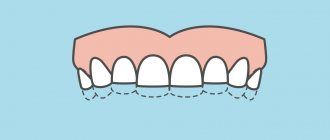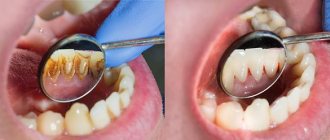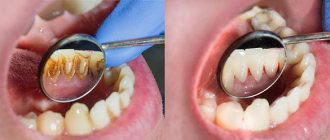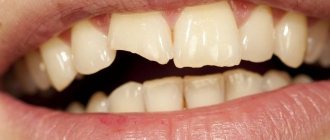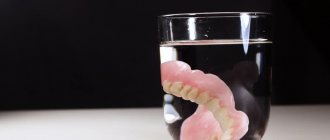A tooth injury is a bruise, dislocation or fracture as a result of a blow, fall or other mechanical impact. Most typical:
- Injury to the front milk teeth in children aged 1-2 years, when children are just starting to walk, but still have poor coordination of movements, often fall and hurt themselves, and run into hard objects.
- Dental trauma at the age of 7-10 years, when children learn to rollerblade and skateboard, play ball, climb, and sometimes fight.
Chronic injury is also possible when a child constantly chews hard objects, and chips of enamel and microcracks appear on the teeth.
IMPORTANT! Information from the article cannot be used for self-diagnosis and self-medication! Only a doctor can prescribe the necessary examinations, establish a diagnosis and draw up a treatment plan during a consultation!
Bruised baby tooth in a child
Most often, bruises occur in preschool children with baby teeth. In appearance, the bruised tooth may not be in an arch with the rest of the teeth, it may look slightly raised above the other teeth due to swelling of the gums. The tooth hurts when chewing and pressing. If a child’s tooth is bruised, what should parents do? The best thing to do in this case is to apply cold to the area of swelling on the face and take the child to the dentist, and if he has determined for sure that this is indeed a bruise, treatment will most likely not be required. It is enough to avoid hard foods for a month to give the tooth the opportunity to “grow” back. In some cases, an incomplete dislocation of the tooth is added to the bruise, and the dentist, under local anesthesia, will set the tooth in place and fix it with a splint.
Methods for treating blue gums
Treatment depends on the cause that caused the blue gum due to the appearance of a hematoma. It should be aimed simultaneously at reducing the focus of the bruise and eliminating the factor - facilitating teething, curing infection or inflammation, opening an abscess.
To alleviate the condition, if a child has hit or fallen, or has torn off and severely injured the gums, cooling compresses and painkillers are used. Warm or hot compresses are unacceptable at first, as they increase blood flow and increase the area of the hematoma on the gum.
Treatment of hematoma due to gum injury
If a child’s gums are blue due to a blow, injury, or bruise, immediately apply a cold compress for 10–15 minutes. As prescribed by the doctor, it is possible to apply ointments for better resorption of the bruise - Heparin and Troxerutin.
The duration of such treatment for a bruise is 5–7 days, then if the child’s symptoms and complaints persist or intensify, it is necessary to contact a dentist and pediatrician.
Painkillers
If there is a bruise on the gum due to contusion and its pain, it is not always possible to do without painkillers, available in the form of syrups, tablets, suppositories and gels for topical use. The choice of medication, dosage and application rules depend on the severity of the symptom, the age of the child, possible violations of tissue integrity and individual characteristics.
In pediatric practice, the following drugs are used for pain relief as prescribed by a specialist:
- Ibuprofen or Nurofen (suspension, tablets, suppositories);
- paracetamol-containing medications (Efferalgan, Paracetamol, Cefekon, Panadol - the same release forms);
- Kamistad Baby, Holisal, Dentinox, Leader in the form of gels.
For infections and inflammations that cause blue tissue, antiviral suppositories Viferon and Genferon are prescribed as an additional remedy. The second medication has an analgesic effect.
Help with teething
To relieve pain, eliminate the bluish area, and improve the child’s well-being, you can help in the following way.
- Use special teethers containing liquid that have a cooling and antipruritic effect, or chewing teethers. For the same purpose, you can use gauze soaked in a cool infusion of chamomile in the form of applications on the painful and damaged blue gum of a baby.
- Topically apply gels to the area that have an analgesic and antiseptic effect, recommended to facilitate teething. In children's practice, Cholisal, Kamistad Baby, Lident, Baby Doctor First Teeth are used.
- To reduce restlessness, tearfulness and capriciousness of the baby, relieve pain, inflammation of tissues, and improve sleep during teething, homeopathic drops Dantinorm baby are recommended. You can also calm the baby by placing it on the mother's breast if he is breastfed.
- To relieve fever, pain and other clinical manifestations of teething and blue gums, Viburkol suppositories are used. They are safe and used for very young children. Among the undesirable manifestations, diarrhea is noted in some cases.
Attention! If a child is bothered by an excessively high temperature, pain, severe swelling of tissues and redness or yellowing with pus, an infectious process may develop. In this case, it is necessary to immediately contact a pediatrician to prescribe urgent, comprehensive treatment.
If the blueness is large, the bruise and suppuration do not go away, and the child is unable to erupt a tooth, surgical treatment is resorted to. To do this, the area of blue or burgundy gums is anesthetized, the mucous membrane is dissected, and the hematoma and pus, if any, are removed. Finally, the wound is washed with antiseptic solutions and recommendations for further treatment and care are given.
Treatment of inflammatory gum diseases in children
To get rid of inflammatory and infectious processes, it is necessary to establish the type of disease that provoked it and eliminate them. For gingivitis the following are prescribed:
- rinsing with antibacterial and antiseptic solutions, if the child does not know how, then applications and wiping;
- application of gels with antimicrobial and antibacterial properties;
- choosing the right toothpaste and brush.
Gingivitis can be caused by insufficient, absent or poor-quality oral care. One of the treatment measures is to eliminate this factor by teaching the little patient the correct actions.
For stomatitis, antiseptics in the form of gels for local application and rinsing, painkillers, and regenerating medications are also used. Antibiotics can only be prescribed by a doctor.
How to treat bruised gums at home
One of the reasons for the appearance of a hematoma on the gum is that the child fell, tore off the mucous membrane and damaged it. In this case, for better healing, prevention or treatment of inflammation, rinsing with antiseptic solutions is necessary - Chlorhexidine, Rotocan, tincture of calendula, chamomile, sage, etc.
Medicines are prescribed in advanced cases, when in addition to bruising, high temperature, soreness of damaged tissue, and suppuration are a concern.
Hemorrhage and hematoma on a child’s gum can occur for various reasons: tooth decay, trauma, oral diseases. To eliminate the symptom, it is necessary to establish the provoking factor together with the doctor and follow his recommendations.
Bibliography
- P. I. Ivasenko - Emergency conditions in outpatient dental practice, M.: Medical book, 2009.
- Major M. Ash, Stanley J. Nelson - Wheeler's Dental Anatomy, Physiology and Occlusion - Saunders - 2002.
- Kuryakina I.V., Kutepova T.F. - Diseases, periodontal disease, N. Novgorod: NGMD, 2000.
- V. A. Zelensky, F. S. Mukhoramov. - Pediatric surgical dentistry and maxillofacial surgery, M.: GEOTAR-Media, 2008.
- Persin L.S., Elizarova V.M., Dyakova S.V. - Pediatric Dentistry, Medicine, 2006.
- Vinogradova T.F., Maksimova O.P., Melnichenko E.M. — Diseases of periodontal and oral mucosa in children, M., 1983.
- Ralph E. McDonald, David R. Avery, Jeffrey A. Dean - Dentistry For The Child And Adolescent - Mosby - 2004
Find a clinic
Tooth dislocation in a child
A tooth is said to be dislocated if the tooth falls out completely as a result of an impact or is turned out of its socket and is supported only by soft tissues. A dislocated baby tooth in a child is usually not treated; the dentist simply removes it permanently. A permanent tooth can be saved if it is dislocated, but only if the roots of the tooth are not broken, and if it is possible to deliver the tooth to a dental clinic within two hours after the injury, and until that moment keep it in water (it is best in mineral water or in milk) so that the pulp does not have time to die. The dentist carefully sets the tooth into place and applies a splint.
Impacted dislocation of a baby tooth also occurs in children. With this injury, the tooth seems to go inside the gum. In this case, the dentist may recommend not to intervene and simply wait until the injured tooth begins to “erupt” again. Do not try to remove it from the socket yourself; this may damage the buds of the permanent tooth under the injured milk tooth.
Types of gum injuries
- Mechanical injury. The most common type of damage. The cause is usually external physical influence. Most often such injuries occur during a fall or from an external blow.
It is possible that injuries may occur during sports activities in strength martial arts - boxing, freestyle wrestling, judo, karate and other sports. Mechanical injuries are easier to diagnose, since in most cases they are accompanied by external injuries, such as bruises, bruises, and even skin tears.
- Chemical injury. Such gum injury may be the result of exposure to chemically active drugs. For an inattentive or in a hurry person, it is quite acceptable that he can confuse externally similar liquids, for example, vinegar and water, or a concentrated solution of manganese and currant juice. After such an impact, the gums receive extensive trauma.
What to do if a child has a dental injury
- If the injury is combined with a fall or a strong blow, you should immediately visit the emergency room and make sure that the child does not have a concussion or fractures, including facial bones - jaw, nose, etc.
- If other injuries are excluded or you are sure that it was the tooth that was damaged, you can immediately go to an urgent appointment with the dentist. If you have a tooth injury, we will see you immediately, since the speed of action often determines whether the tooth can be saved.
- The dentist numbs the area of the injury, determines the type of injury and prescribes treatment. In some cases it starts immediately, sometimes you need to wait a little. Treatment of a tooth injury can last up to a month.
It is important to correctly diagnose and treat an injured tooth to prevent complications. Meet our tooth fairies and check prices.
First aid for gum injuries
Regardless of the type of injury, first aid must be provided immediately. First, you should remove all foreign pieces or parts of a broken tooth from the gums. After that:
- In case of a mechanical injury, the main rule is rest and immediate treatment of the gums with a disinfectant. Such drugs include a weak solution of manganese, furatsilin, a 5% alcohol solution and other available liquid medicines. If the injured person cannot rinse his mouth on his own, then the mouth should be cleaned using cotton-gauze balls.
- For burns, the initial action should be to rinse the mouth with plenty of cool water. If your gums are burned, in most cases it is necessary to call an emergency doctor to prevent the development of more complex forms of the disease.
You should not be afraid of the unknown, of what you are encountering for the first time. It is necessary to seek help from specialists in the first minutes. This is the only way to avoid complications and undesirable effects in the damaged part of the gum. The doctor will also prescribe painkillers for increasing pain.
Prevention of dental injuries
There are typical situations in which children injure their teeth. For example, a quarter of front tooth injuries between the ages of 1 and 3 years occur in the bathtub when a child slips and hits the edge of the bathtub, so try not to leave your baby unattended in the bathtub. Pay attention to protecting your teeth with a mouthguard when your child plays sports, especially hard and contact sports (hockey, various types of wrestling, basketball), rollerblading or skateboarding. Contact your orthodontist in a timely manner, because... a large percentage of injuries to permanent teeth are associated with their incorrect position, i.e. existing bite pathology, which means an additional risk.
At the same time, you should not blame yourself for not looking after your child and causing dental injury. Children are restless, they love to explore the world and take risks, and we cannot always protect them from such accidents.
make an appointment with a pediatric dentist online or by phone: +7(812)3310000
Causes of suppuration
If you have purulent discharge from your gums, there is a pimple in which pus accumulates, you feel pain, your teeth ache, then you should not hesitate, but immediately go to the doctor. If you start a purulent inflammation that has formed in the gum, serious consequences can occur. All this can even lead to blood poisoning.
As for a purulent pimple, it can be of any size. For some, it may resemble a pea in shape, and sometimes it can reach the size of half a walnut. But it is worth knowing that you cannot judge the severity of the problem by the size of this pimple. If there is a purulent pimple and it is small, then if left untreated, it can increase significantly within a day.
Suppuration can occur for the following reasons:
- The gum was injured by a fragment of a tooth that was broken. A poor quality crown that hangs over the edge of the gum can also scratch the gums;
- hygiene procedures were performed using a very hard toothbrush;
- a man carelessly picked his teeth with a toothpick.
You should know and understand that every manipulation that relates to teeth must be carried out carefully and carefully so as not to touch the gums. If pus appears, a person must realize that there is already an inflammatory process. And it needs to be treated without delay.
How the disease develops
Initially, a person does not suffer due to the fact that a slight suppuration has formed. Pain may occur when he eats, bleeding may appear when he brushes his teeth, or pus may be released if he presses on the root of a tooth. Later, there is more and more pus in the gum, which leads to the spread of infection. If the necessary treatment is not given, healthy teeth may begin to fall out.
When the disease just begins, pus accumulates in one tooth, but after a while it can spread to other teeth and take the form of chronic periodontal disease. Therefore, as soon as you see suppuration, go to a specialist and consult with him.
Thanks to modern medications and treatment methods, suppuration in the gums can be quickly and easily cured. But they should be prescribed exclusively by dentists.
What to do?
The main thing is never to heat the place that hurts. Once upon a time, grandmothers said that you need to bandage your cheek with a warm scarf, but you shouldn’t do this. Inflammation cannot be heated. If the temperature rises, the process becomes even stronger. If there is pus, you should apply a piece of ice to the area that hurts.
If the pus comes out of the gums, you shouldn’t think that everything is gone. Drug treatment is necessary to stop the process. But antibiotics must be prescribed by a doctor.



